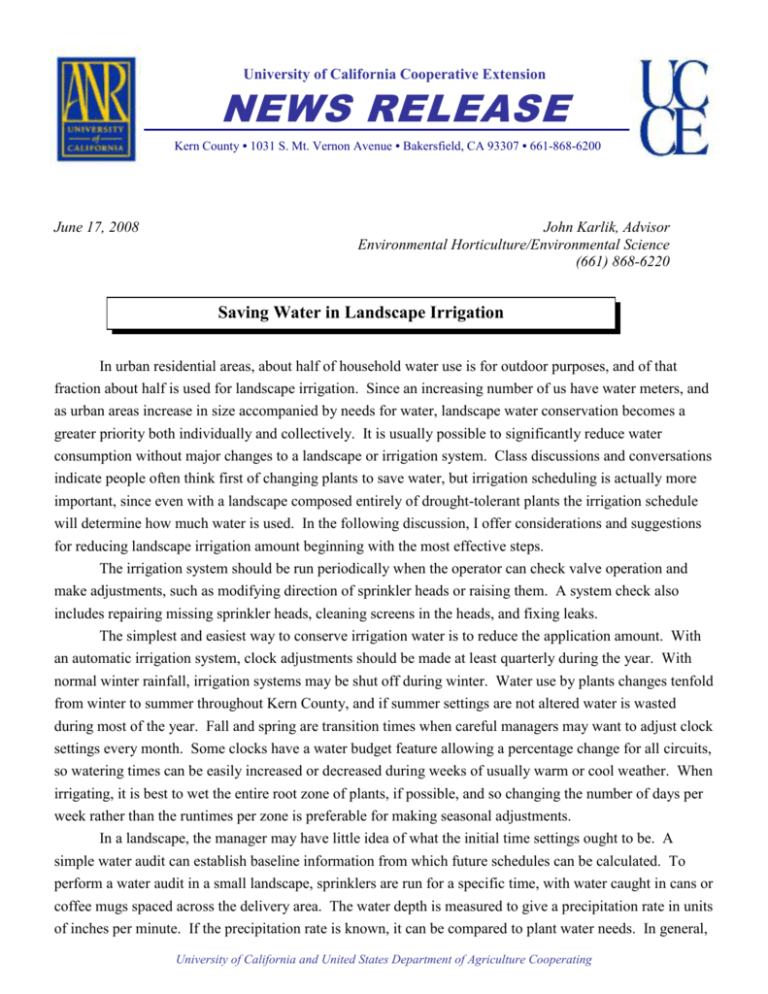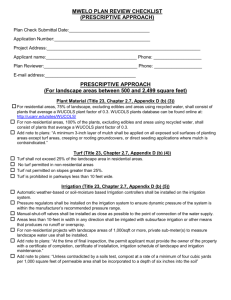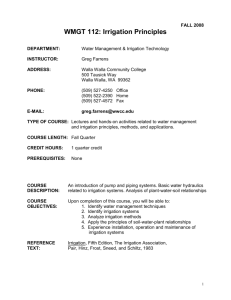JK NR 06-17-08
advertisement

University of California Cooperative Extension NEWS RELEASE Kern County • 1031 S. Mt. Vernon Avenue • Bakersfield, CA 93307 • 661-868-6200 June 17, 2008 John Karlik, Advisor Environmental Horticulture/Environmental Science (661) 868-6220 Saving Water in Landscape Irrigation In urban residential areas, about half of household water use is for outdoor purposes, and of that fraction about half is used for landscape irrigation. Since an increasing number of us have water meters, and as urban areas increase in size accompanied by needs for water, landscape water conservation becomes a greater priority both individually and collectively. It is usually possible to significantly reduce water consumption without major changes to a landscape or irrigation system. Class discussions and conversations indicate people often think first of changing plants to save water, but irrigation scheduling is actually more important, since even with a landscape composed entirely of drought-tolerant plants the irrigation schedule will determine how much water is used. In the following discussion, I offer considerations and suggestions for reducing landscape irrigation amount beginning with the most effective steps. The irrigation system should be run periodically when the operator can check valve operation and make adjustments, such as modifying direction of sprinkler heads or raising them. A system check also includes repairing missing sprinkler heads, cleaning screens in the heads, and fixing leaks. The simplest and easiest way to conserve irrigation water is to reduce the application amount. With an automatic irrigation system, clock adjustments should be made at least quarterly during the year. With normal winter rainfall, irrigation systems may be shut off during winter. Water use by plants changes tenfold from winter to summer throughout Kern County, and if summer settings are not altered water is wasted during most of the year. Fall and spring are transition times when careful managers may want to adjust clock settings every month. Some clocks have a water budget feature allowing a percentage change for all circuits, so watering times can be easily increased or decreased during weeks of usually warm or cool weather. When irrigating, it is best to wet the entire root zone of plants, if possible, and so changing the number of days per week rather than the runtimes per zone is preferable for making seasonal adjustments. In a landscape, the manager may have little idea of what the initial time settings ought to be. A simple water audit can establish baseline information from which future schedules can be calculated. To perform a water audit in a small landscape, sprinklers are run for a specific time, with water caught in cans or coffee mugs spaced across the delivery area. The water depth is measured to give a precipitation rate in units of inches per minute. If the precipitation rate is known, it can be compared to plant water needs. In general, University of California and United States Department of Agriculture Cooperating average per-day water requirements for landscapes are 0.25, 0.16, 0.02, and 0.15 inches for summer, autumn, winter and spring, respectively, in the valley portion of Kern County. Soil and plants should be monitored and irrigation adjusted accordingly. Plants indicate moisture stress by color change, or in more advanced condition, by wilting. Soils can be occasionally checked with a soil probe or screwdriver to gauge the depth of water penetration. If runoff occurs, multiple short cycles may be necessary to apply the needed amount of water. Some types of turf heads, such as stream rotors, offer low precipitation rates for soils with low infiltration rates. Early morning is the best time of day to irrigate to minimize water loss from wind and evaporation. Mulching around plants can reduce soil evaporation and help provide more uniform moisture. A non-uniform irrigation system, especially on turf, can waste large amounts of water, because it is common for homeowners to irrigate until the driest spot is wet, which may result in twice as much water as needed in other areas. In general, the output from a sprinkler should reach the adjacent sprinkler (head-tohead coverage). High overall uniformity can be obtained with single-stream heads, stream rotors, or impact sprinklers. Fan-sprays are more difficult to work with to achieve high coefficients of uniformity but are needed for irregularly shaped areas. For shrubs, groundcovers and trees, drip irrigation is often a useful method for water delivery. The landscape design, including the irrigation design, often sets limits on water conservation. Plants with similar water requirements should be in the same irrigation zone, and plants on the same irrigation line should need similar amounts and frequency of irrigation. For example, in a residential landscape, turf should be irrigated from one or more lines, shrubs and groundcovers on others, fruit trees on others, and so forth. These plant types may need different frequencies of irrigation, in other words, more or fewer days per week. Low-priced irrigation controllers used for home landscapes may not allow setting days on/off independently for each valve. Improved controllers are now available that allow greater flexibility in scheduling. For a drip system, one cost-effective solution is to have two inexpensive irrigation controllers, one for valves operating most days per week, and a second for valves operating once or twice per week for long periods of time. University of California and United States Department of Agriculture Cooperating









